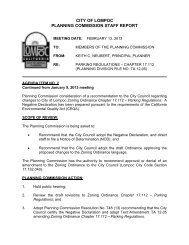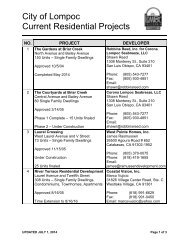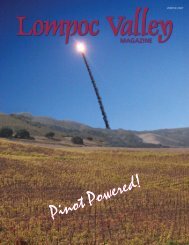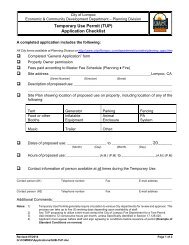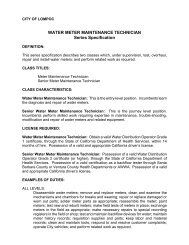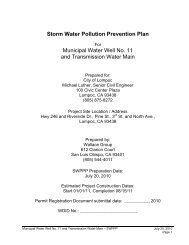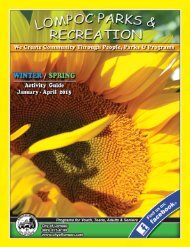Noise and Air Quality - the City of Lompoc!
Noise and Air Quality - the City of Lompoc!
Noise and Air Quality - the City of Lompoc!
- No tags were found...
You also want an ePaper? Increase the reach of your titles
YUMPU automatically turns print PDFs into web optimized ePapers that Google loves.
Issue Paper on<strong>Noise</strong> <strong>and</strong> <strong>Air</strong> <strong>Quality</strong><strong>City</strong> <strong>of</strong> <strong>Lompoc</strong> General Plan UpdatePrepared by:Rincon Consultants, Inc.1530 Monterey Street, Suite DSan Luis Obispo, California 93401July 2008
<strong>City</strong> <strong>of</strong> <strong>Lompoc</strong> General Plan UpdateIssue Paper on <strong>Noise</strong> <strong>and</strong> <strong>Air</strong> <strong>Quality</strong> IssuesSETTING<strong>Noise</strong>Background. <strong>Noise</strong> has been defined as unwanted sound <strong>and</strong> is known to have severaladverse effects on people. From <strong>the</strong>se known effects <strong>of</strong> noise, criteria have been established tohelp protect <strong>the</strong> public health <strong>and</strong> safety <strong>and</strong> prevent disruption <strong>of</strong> certain human activities.These criteria are based on known impacts <strong>of</strong> noise on people such as hearing loss, speechinterference, sleep interference, physiological responses <strong>and</strong> annoyance.Sound is technically described in terms <strong>of</strong> <strong>the</strong> loudness (amplitude) <strong>of</strong> <strong>the</strong> sound <strong>and</strong> frequency(pitch) <strong>of</strong> <strong>the</strong> sound. The st<strong>and</strong>ard unit <strong>of</strong> measurement <strong>of</strong> <strong>the</strong> loudness <strong>of</strong> sound is <strong>the</strong> Decibel(dB). Since <strong>the</strong> human ear is not equally sensitive to sound at all frequencies, <strong>the</strong> A-weighteddecibel scale (dBA) relates noise to human sensitivity by discriminating against frequencies in amanner similar to <strong>the</strong> human ear.Decibels are based on <strong>the</strong> logarithmic scale, which compresses <strong>the</strong> wide range in soundpressure levels to a more usable range <strong>of</strong> numbers just as <strong>the</strong> Richter scale measuresearthquakes. In terms <strong>of</strong> human response to noise, a sound 10 dBA higher than ano<strong>the</strong>r isjudged to be twice as loud; a sound 20 dBA higher four times as loud, <strong>and</strong> so forth. Everydaysounds normally range from 30 dB (very quiet) to 100 dB (very loud). In general, a 3 dB changein community noise levels is noticeable, while 1-2 dB changes are generally not perceived.In addition to <strong>the</strong> actual instantaneous measurement <strong>of</strong> sound levels, <strong>the</strong> duration <strong>of</strong> sound isimportant since sounds that occur over a long period <strong>of</strong> time are more likely to be an annoyanceor cause direct physical damage or environmental stress. Several rating scales have beendeveloped to account for <strong>the</strong> known effects <strong>of</strong> noise on people. Based on <strong>the</strong>se effects, <strong>the</strong>observation has been made that <strong>the</strong> potential for noise to impact people is dependent on <strong>the</strong>total acoustical energy content <strong>of</strong> <strong>the</strong> noise. A number <strong>of</strong> noise scales have been developed toaccount for this factor, including <strong>the</strong> Equivalent <strong>Noise</strong> Level (Leq), <strong>the</strong> Day Night <strong>Noise</strong> Level(LDN) <strong>and</strong> <strong>the</strong> Community <strong>Noise</strong> Equivalent Level (CNEL).Intermittent or occasional noise such as that associated with stationary noise sources is not <strong>of</strong>sufficient volume to exceed community noise st<strong>and</strong>ards that are based on a time averagedscale such as <strong>the</strong> LDN scale. To account for intermittent noise, <strong>the</strong> Percent <strong>Noise</strong> Level (L%)scale is used. The Percent <strong>Noise</strong> Level is <strong>the</strong> level exceeded a percentage <strong>of</strong> <strong>the</strong> time during<strong>the</strong> measurement period. <strong>Noise</strong> Ordinances are typically specified in terms <strong>of</strong> <strong>the</strong> percent noiselevels. Ordinances are designed to protect people from noise sources such as music,machinery <strong>and</strong> vehicular traffic on private property.Local Issues. Existing noise sources in <strong>the</strong> region include roadway noise, agriculturalproduction, <strong>the</strong> Union Pacific Railroad, <strong>Lompoc</strong> <strong>Air</strong>port, <strong>and</strong> mining operations. <strong>Noise</strong> issuesare currently primarily from vehicle noise from roadways. <strong>Noise</strong> generated by roadways isdependant on <strong>the</strong> speed <strong>and</strong> volume <strong>of</strong> vehicles that use <strong>the</strong> roadways.1<strong>City</strong> <strong>of</strong> <strong>Lompoc</strong>
<strong>City</strong> <strong>of</strong> <strong>Lompoc</strong> General Plan UpdateIssue Paper on <strong>Noise</strong> <strong>and</strong> <strong>Air</strong> <strong>Quality</strong> IssuesO<strong>the</strong>r noise sources that contribute to <strong>the</strong> ambient level include agricultural production activities;noise from <strong>the</strong> <strong>Lompoc</strong> <strong>Air</strong>port or <strong>the</strong> V<strong>and</strong>enberg <strong>Air</strong>port, depending on <strong>the</strong>ir approach <strong>and</strong>take-<strong>of</strong>f flight patterns, as well as <strong>the</strong> distance between <strong>the</strong> sensitive uses <strong>and</strong> <strong>the</strong> airports; localdiatomaceous earth mining operations; as well as <strong>the</strong> Union Pacific Railroad that bisects <strong>the</strong><strong>City</strong> in generally an east to west direction. <strong>Noise</strong> generated by <strong>the</strong> railroad is limited to a fewtrips per week that occur on this section <strong>of</strong> track since it primarily serves as a cargo rail thatdelivers to <strong>and</strong> from V<strong>and</strong>enberg <strong>Air</strong> Force Base to <strong>the</strong> northwest <strong>of</strong> <strong>the</strong> <strong>City</strong>. The actual timing<strong>and</strong> volume <strong>of</strong> trains that use <strong>the</strong> tracks is confidential; <strong>the</strong>refore, actual noise levels cannot beestimated with any certainty. Sound walls or o<strong>the</strong>r barriers between <strong>the</strong> tracks <strong>and</strong> futureresidential development near <strong>the</strong> railroad can help abate noise issues.Table 1<strong>City</strong> <strong>Noise</strong> St<strong>and</strong>ardsLAND USE CATEGORIESCNELCATEGORIES USES INTERIOR 1 EXTERIORResidentialSingle Family, Duplex, Multiple Family,Mobile Home45 60Commercial & Retail, Restaurant 55 65Industrial Motel 45 60CommunityFacilityPr<strong>of</strong>essional Offices, Movie Theater, AuditoriumManufacturing, Utilities, Warehousing,AgricultureHospital, School, Nursing Home, Church,Library, Civic Offices, Parks45 6565 7545 65Open Space Passive Outdoor Recreation -- 60<strong>Air</strong> <strong>Quality</strong>Background. <strong>Lompoc</strong> is part <strong>of</strong> <strong>the</strong> South Central Coast <strong>Air</strong> Basin (SCCAB), which includes all<strong>of</strong> San Luis Obispo, Santa Barbara, <strong>and</strong> Ventura counties. The climate <strong>of</strong> <strong>the</strong> Santa Barbarafoothills <strong>and</strong> <strong>of</strong> <strong>the</strong> SCCAB is strongly influenced by its proximity to <strong>the</strong> Pacific Ocean <strong>and</strong> <strong>the</strong>location <strong>of</strong> <strong>the</strong> semi-permanent high pressure cell in <strong>the</strong> nor<strong>the</strong>astern Pacific. With aMediterranean-type climate, <strong>the</strong> <strong>City</strong> is characterized by warm, dry summers <strong>and</strong> cool winterswith occasional rainy periods.Cool, humid marine air causes frequent fog <strong>and</strong> low clouds along <strong>the</strong> coast, generally during <strong>the</strong>night <strong>and</strong> morning hours in <strong>the</strong> late spring <strong>and</strong> early summer months. The region is subject to adiurnal cycle in which daily onshore winds from <strong>the</strong> west <strong>and</strong> northwest are replaced by mild<strong>of</strong>fshore breezes flowing from warm inl<strong>and</strong> valleys during night <strong>and</strong> early morning hours. Thisalternating cycle can create a situation where suspended pollutants are swept <strong>of</strong>fshore at night,2<strong>City</strong> <strong>of</strong> <strong>Lompoc</strong>
<strong>City</strong> <strong>of</strong> <strong>Lompoc</strong> General Plan UpdateIssue Paper on <strong>Noise</strong> <strong>and</strong> <strong>Air</strong> <strong>Quality</strong> Issues<strong>and</strong> <strong>the</strong>n carried back onshore <strong>the</strong> following day. Dispersion <strong>of</strong> pollutants is fur<strong>the</strong>r degradedwhen <strong>the</strong> wind velocity for both day <strong>and</strong> nighttime breezes is low.The region is also subject to seasonal “Santa Ana” winds. These are typically hot, dry nor<strong>the</strong>rlywinds which blow <strong>of</strong>fshore at 15-20 mph, but can reach speeds <strong>of</strong> over 60 mph. Two types <strong>of</strong>temperature inversions (warmer air on top <strong>of</strong> cooler air) are created in <strong>the</strong> area: subsidence <strong>and</strong>radiational. The subsidence inversion is a regional effect created by <strong>the</strong> Pacific high in which airis heated as it is compressed when it flows from <strong>the</strong> high pressure area to <strong>the</strong> low pressureareas inl<strong>and</strong>. This type <strong>of</strong> inversion generally forms at about 1,000 to 2,000 feet <strong>and</strong> can occurthroughout <strong>the</strong> year, but it is most evident during <strong>the</strong> summer months. Surface inversions areformed by <strong>the</strong> more rapid cooling <strong>of</strong> air near <strong>the</strong> ground during <strong>the</strong> night, especially duringwinter. This type <strong>of</strong> inversion is typically lower (0-500 feet at V<strong>and</strong>enberg AFB, for example)<strong>and</strong> is generally accompanied by stable air. Both types <strong>of</strong> inversions limit <strong>the</strong> dispersal <strong>of</strong> airpollutants within <strong>the</strong> regional airshed, with <strong>the</strong> more stable <strong>the</strong> air (low wind speeds, uniformtemperatures), <strong>the</strong> lower <strong>the</strong> amount <strong>of</strong> pollutant dispersion.The APCD is required to monitor air pollutant levels to assure that applicable air qualityst<strong>and</strong>ards are met, <strong>and</strong> if <strong>the</strong>y are not met, to develop strategies to meet <strong>the</strong> st<strong>and</strong>ards.Depending on whe<strong>the</strong>r <strong>the</strong> st<strong>and</strong>ards are met or exceeded, <strong>the</strong> air basin is classified as being in“attainment” or as “non-attainment”.Local Issues. Santa Barbara County is considered in attainment <strong>of</strong> <strong>the</strong> federal eight-hour ozonest<strong>and</strong>ard, but does not meet <strong>the</strong> state one-hour ozone st<strong>and</strong>ard or <strong>the</strong> st<strong>and</strong>ard for particulatematter less than ten microns in diameter (PM 10 ). The County is in attainment for all o<strong>the</strong>rst<strong>and</strong>ards. Table 2 summarizes <strong>the</strong> annual air quality data for <strong>the</strong> local airshed.Table 2Ambient <strong>Air</strong> <strong>Quality</strong> Data at <strong>the</strong> S H Street Monitoring StationPollutant 2004 2005 2006Ozone, ppm – Worst Hour 0.084 0.064 0.056Number <strong>of</strong> days <strong>of</strong> State exceedances (>0.09 ppm) 0 0 0Number <strong>of</strong> days <strong>of</strong> Federal exceedances (>0.12 ppm) 0 0 0Particulate Matter 50 μg/m 3 ) 1 1 0Number <strong>of</strong> samples <strong>of</strong> Federal exceedances (>150 μg/m 3 ) 0 0 0Nitrogen Dioxide (ppm), Worst Hour 0.036 0.035 0.037Number <strong>of</strong> days <strong>of</strong> State exceedances (>0.25 ppm) 0 0 0Source: CARB 2004-2006Man-made sources <strong>of</strong> PM 10 include agricultural operations, industrial processes, combustion <strong>of</strong>fossil fuels, construction <strong>and</strong> demolition operations, <strong>and</strong> entrainment <strong>of</strong> road dust into <strong>the</strong>atmosphere. Natural sources include wind blown dust, wildfire smoke, <strong>and</strong> sea spray salt. Dueto <strong>the</strong> County’s non-attainment status for state PM 10 st<strong>and</strong>ards, future development within <strong>the</strong><strong>City</strong> is required to implement <strong>the</strong> Santa Barbara County <strong>Air</strong> Pollution Control District (APCD)best management practices intended to reduce PM 10 emissions.3<strong>City</strong> <strong>of</strong> <strong>Lompoc</strong>
<strong>City</strong> <strong>of</strong> <strong>Lompoc</strong> General Plan UpdateIssue Paper on <strong>Noise</strong> <strong>and</strong> <strong>Air</strong> <strong>Quality</strong> IssuesGlobal Climate Change. Global climate change (GCC) refers to a change in <strong>the</strong> averagewea<strong>the</strong>r <strong>of</strong> <strong>the</strong> earth which can be measured by wind patterns, storms, precipitation, <strong>and</strong>temperature. The impact <strong>of</strong> anthropogenic activities on GCC is evident in <strong>the</strong> scientificcorrelation between rising global temperatures, atmospheric concentrations <strong>of</strong> CO 2 <strong>and</strong> o<strong>the</strong>rgreenhouse gases (GHGs), <strong>and</strong> <strong>the</strong> industrial revolution 1 .The greenhouse effect is a natural process by which some <strong>of</strong> <strong>the</strong> radiant heat from <strong>the</strong> sun iscaptured in <strong>the</strong> lower atmosphere <strong>of</strong> <strong>the</strong> earth. The gases that help capture <strong>the</strong> heat are calledGHGs. While GHGs are not normally considered air pollutants, all have been identified asforcing <strong>the</strong> earth’s atmosphere <strong>and</strong> oceans to warm above naturally occurring temperatures.Some GHGs occur naturally in <strong>the</strong> atmosphere, while o<strong>the</strong>rs result from human activities.Naturally occurring GHGs include water vapor, carbon dioxide, methane, nitrous oxide <strong>and</strong>ozone. Certain human activities add to <strong>the</strong> levels <strong>of</strong> most <strong>of</strong> <strong>the</strong>se naturally occurring gases.Of all <strong>the</strong> greenhouse gases in <strong>the</strong> atmosphere, water vapor is <strong>the</strong> most abundant <strong>and</strong> variable.The main source <strong>of</strong> water vapor is evaporation from <strong>the</strong> oceans (approximately 85%). O<strong>the</strong>rsources include evaporation from o<strong>the</strong>r water bodies, sublimation (change from solid to gas)from ice <strong>and</strong> snow, <strong>and</strong> transpiration from plant leaves. The primary human-related source <strong>of</strong>water vapor comes from fuel combustion in motor vehicles. However, this is believed tocontribute a negligible amount (less than 1%) to atmospheric concentrations <strong>of</strong> water vapor. Asa result, <strong>the</strong> control <strong>and</strong> reduction <strong>of</strong> water vapor emissions is not within reach <strong>of</strong> humanactions, <strong>and</strong> is <strong>the</strong>refore excluded from regulation under California law.The second most prevalent GHG is carbon dioxide (CO 2 ). Natural sources <strong>of</strong> CO 2 include:decomposition <strong>of</strong> dead organic matter; respiration <strong>of</strong> bacteria, plants, animals, <strong>and</strong> fungus;evaporation from oceans; <strong>and</strong> volcanic outgassing. However, in contrast to water vapor, CO 2 isprimarily generated by anthropogenic (human caused) sources, including burning coal, oil,natural gas <strong>and</strong> wood.After CO 2, <strong>the</strong> GHGs over which humans have <strong>the</strong> greatest control are methane (CH 4 ) <strong>and</strong>nitrous oxide (N 2 O). CH 4 is a flammable gas <strong>and</strong> is <strong>the</strong> main component <strong>of</strong> natural gas. Naturalsources <strong>of</strong> CH 4 include anaerobic decay <strong>of</strong> organic matter <strong>and</strong> natural gas fields; anthropogenicsources include l<strong>and</strong>fills, fermentation <strong>of</strong> manure, <strong>and</strong> cattle. N 2 O is produced by microbialprocesses in soils <strong>and</strong> water, including those reactions which occur in fertilizer containingnitrogen. Anthropogenic sources <strong>of</strong> N 2 O include agricultural soil management, animal manuremanagement, sewage treatment, <strong>and</strong> mobile <strong>and</strong> stationary combustion <strong>of</strong> fossil fuel. Reducingemissions from CO 2, CH 4 <strong>and</strong> N 2 O is <strong>the</strong> focus <strong>of</strong> state GHG regulations.In June 2005, Governor Schwarzenegger signed Executive Order S-3-05, acknowledging <strong>the</strong>environmental impacts <strong>of</strong> greenhouse gas emissions on climate change. The Executive Orderestablished <strong>the</strong> following climate change emission reduction targets for California:1 Intergovernmental Panel on Climate Change (IPCC). Climate Change 2001: The Scientific Basis.Cambridge University Press, 2001.4<strong>City</strong> <strong>of</strong> <strong>Lompoc</strong>
<strong>City</strong> <strong>of</strong> <strong>Lompoc</strong> General Plan UpdateIssue Paper on <strong>Noise</strong> <strong>and</strong> <strong>Air</strong> <strong>Quality</strong> Issues• By 2010, reduce greenhouse gas emissions to 2000 levels.• By 2020, reduce greenhouse gas emissions to 1990 levels.• By 2050, reduce greenhouse gas emission to 80 percent below 1990 levels.In response to <strong>the</strong> Executive Order, Cal/EPA established <strong>the</strong> Climate Action Team to developstrategies for reducing climate change emissions in <strong>the</strong> State. In March 2006, Cal/EPA releaseda document called <strong>the</strong> Climate Action Team Report to Governor Schwarzenegger <strong>and</strong>Legislature. The Report provides suggested strategies for reducing climate change emissionsthat would be implemented by State agencies over <strong>the</strong> next 2 years. It is a guidance documentto be used by <strong>the</strong> identified State agencies in developing statewide programs for reducingclimate change emissions.The Executive Order also directed <strong>the</strong> California Environmental Protection Agency (Cal/EPA) tocoordinate efforts among State agencies to meet <strong>the</strong>se targets. As part <strong>of</strong> this directive, in 2006<strong>the</strong> California State Legislature adopted AB 32, <strong>the</strong> California Global Warming Solutions Act <strong>of</strong>2006, which <strong>the</strong> Governor signed on September 27, 2006. AB 32 represents <strong>the</strong> firstenforceable statewide program to limit GHG emissions from all major industries with penaltiesfor noncompliance. It requires Cal/EPA to lead <strong>the</strong> evaluation <strong>of</strong> California’s impacts on climatechange <strong>and</strong> identify mitigation strategies to reduce emissions <strong>and</strong> adaptive measures tominimize adverse effects <strong>of</strong> climate change. The California <strong>Air</strong> Resources Board (CARB) hasbeen assigned to carry out <strong>and</strong> develop <strong>the</strong> programs <strong>and</strong> requirements necessary to achieve<strong>the</strong> goals <strong>of</strong> AB 32. By January 2008, a statewide cap for 2020 emissions based on 1990 levelsmust be adopted. The following year (January 2009), CARB must adopt m<strong>and</strong>atory reportingrules for major sources <strong>of</strong> GHGs <strong>and</strong> also a plan indicating how reductions in significant GHGsources will be achieved through regulations, market mechanisms, <strong>and</strong> o<strong>the</strong>r actions.Relationship to <strong>the</strong> General Plan<strong>Noise</strong><strong>Noise</strong> is <strong>of</strong> special concern to <strong>the</strong> State with respect to General Plans. It is one <strong>of</strong> <strong>the</strong> seventopics required to be addressed in a specific Element under state planning law. The State Office<strong>of</strong> Planning <strong>and</strong> Research <strong>Noise</strong> Element Guidelines require that major noise sources beidentified <strong>and</strong> quantified through <strong>the</strong> preparation <strong>of</strong> generalized noise contours for current <strong>and</strong>projected conditions. This is intended to guide <strong>the</strong> l<strong>and</strong> use pattern in order to minimize <strong>the</strong>community’s exposure to current noise issues, as well as shield <strong>the</strong> community from noisecreated by future development. L<strong>and</strong> use changes identified in <strong>the</strong> Housing Element <strong>and</strong> L<strong>and</strong>Use Element can result in noise increases directly (e.g., from zoning <strong>of</strong> additional industrialnoise sources) <strong>and</strong> indirectly (e.g., from vehicle trips associated with future development). Inaddition, transportation improvements identified in <strong>the</strong> Circulation Element (e.g., road wideningsor extensions) could bring traffic noise sources closer to existing or planned receptors. The<strong>Noise</strong> Element acts in concert with <strong>the</strong>se elements to ensure that <strong>City</strong> noise st<strong>and</strong>ards are metthroughout <strong>the</strong> General Plan buildout period. It should be noted that <strong>the</strong> first phase <strong>of</strong> <strong>the</strong>General Plan Update process includes updating <strong>the</strong> Housing, L<strong>and</strong> Use, <strong>and</strong> CirculationElements, <strong>and</strong> <strong>the</strong> subsequent phase includes updating <strong>the</strong> <strong>Noise</strong> Element. The EnvironmentalImpact Report for <strong>the</strong> first phase element will identify noise impacts associated with updated5<strong>City</strong> <strong>of</strong> <strong>Lompoc</strong>
<strong>City</strong> <strong>of</strong> <strong>Lompoc</strong> General Plan UpdateIssue Paper on <strong>Noise</strong> <strong>and</strong> <strong>Air</strong> <strong>Quality</strong> Issuesbuildout estimates, <strong>and</strong> will potentially include recommended <strong>Noise</strong> Element policy changes asmitigation. Such policy changes would be implemented as part <strong>of</strong> <strong>the</strong> second phase <strong>of</strong> <strong>the</strong>process.<strong>Air</strong> <strong>Quality</strong>There is no requirement for an air quality element in <strong>the</strong> General Plan, but it is among <strong>the</strong> morecommon optional elements employed. In <strong>the</strong> existing <strong>Lompoc</strong> General Plan air quality is dealtwith as a part <strong>of</strong> <strong>the</strong> Resource Conservation Element, which states:“Consideration <strong>of</strong> air quality as a resource in <strong>the</strong> General Plan is provided sinceseveral <strong>of</strong> <strong>the</strong> m<strong>and</strong>atory elements have effects on air quality <strong>and</strong> emissionsources:o The L<strong>and</strong> Use Element governs <strong>the</strong> location <strong>and</strong> intensity <strong>of</strong> stationarycommercial <strong>and</strong> industrial emission sources;o The Circulation Element addresses <strong>the</strong> location <strong>and</strong> extent <strong>of</strong>highways used by automobiles <strong>and</strong> mobile sources;o The Conservation Element requires discussion <strong>of</strong> <strong>the</strong> conservation <strong>of</strong>natural resources, <strong>and</strong>o The Open Space Element addresses use <strong>of</strong> open space l<strong>and</strong>s for <strong>the</strong>enhancement <strong>of</strong> air quality.”The existing General Plan includes goals <strong>and</strong> policies that relate to air quality, includingmonitoring <strong>and</strong> improvement <strong>of</strong> <strong>the</strong> air quality in <strong>the</strong> <strong>Lompoc</strong> Valley, <strong>and</strong> minimizing emissionsfrom vehicles, including planes associated with <strong>the</strong> <strong>Lompoc</strong> <strong>Air</strong>port.As with noise issues, air quality policies will be addressed as part <strong>of</strong> <strong>the</strong> Resource ConservationElement update in <strong>the</strong> second phase <strong>of</strong> <strong>the</strong> General Plan Update program, following updates to<strong>the</strong> Housing, L<strong>and</strong> Use, <strong>and</strong> Circulation Elements. The Environmental Impact Report for <strong>the</strong>first phase elements will identify air quality impacts associated with updated buildout estimates,<strong>and</strong> will potentially include recommended Resource Conservation Element policy changes asmitigation. Such policy changes would be implemented as part <strong>of</strong> <strong>the</strong> second phase <strong>of</strong> <strong>the</strong>process.POLICY CONSIDERATIONS• <strong>Noise</strong> Policy ConsiderationsDevelopment patterns should be strategically planned to reduce noise impacts onproposed sensitive residential l<strong>and</strong> uses. Structural setbacks, noise barriers, <strong>and</strong>/orstructural features will help reduce <strong>the</strong> noise levels in areas near roadways with highprojected future traffic levels. Additionally, residences can be oriented such that <strong>the</strong>sensitive uses (bedrooms, balconies, <strong>and</strong> <strong>of</strong>fices) are located away from <strong>the</strong> noisesources.6<strong>City</strong> <strong>of</strong> <strong>Lompoc</strong>
<strong>City</strong> <strong>of</strong> <strong>Lompoc</strong> General Plan UpdateIssue Paper on <strong>Noise</strong> <strong>and</strong> <strong>Air</strong> <strong>Quality</strong> IssuesAssorted agricultural operations are located outside <strong>the</strong> <strong>City</strong> Limits. Agriculturaloperations produce noise associated with <strong>the</strong> following equipment: wind machines,diesel engines, aerial application aircrafts (crop dusters), <strong>and</strong> tractors. The County’sRight-to- Farm Ordinance states that no agricultural activity, operation, or facility shall bedeemed or become a nuisance due to any changed condition in <strong>the</strong> locality, after <strong>the</strong>agricultural use has been in operation for at least three years. L<strong>and</strong> use buffers <strong>and</strong>o<strong>the</strong>r noise screening techniques can greatly reduce noise nuisances on adjacentreceptors.• <strong>Air</strong> <strong>Quality</strong> Policy ConsiderationsThe General Plan update can encourage development patterns that promote <strong>the</strong> use <strong>of</strong>alternative modes <strong>of</strong> transportation, <strong>the</strong>reby incrementally reducing air contaminantemissions, including greenhouse gas emissions. The APCD recommends mixed usedevelopments that combine residential, employment, <strong>and</strong> retail uses. Sidewalks, safestreet <strong>and</strong> parking lot crossings, shade trees, <strong>of</strong>f-street breezeways, alleys, <strong>and</strong> shower<strong>and</strong> locker facilities for employee bicyclists are also recommended by APCD toencourage alternative transportation modes. Building entrances should favorpedestrians ra<strong>the</strong>r than cars. Future development should provide on-site services thatreduce <strong>the</strong> need for <strong>of</strong>f-site travel. These services may include but are not limited to:childcare facilities, telecommunication centers, neighborhood retail stores, postalmachines, <strong>and</strong> automatic teller machines.The APCD also recommends energy conservation measures to reduce natural gas <strong>and</strong>electricity consumption. These measures include:• Photovoltaic <strong>and</strong> wind generators;• Duct system within <strong>the</strong> building <strong>the</strong>rmal envelope;• Passive cooling strategies;• High efficiency, motion controlled outdoor lighting;• Natural lighting in buildings;• Building siting <strong>and</strong> orientation, <strong>and</strong> l<strong>and</strong>scaping to reduce energy use;• Summer shading <strong>and</strong> wind protection measures;• Use <strong>of</strong> concrete or o<strong>the</strong>r non-polluting materials for parking lots instead <strong>of</strong>asphalt;• Installation <strong>of</strong> energy efficient appliances <strong>and</strong> lighting;• Installation <strong>of</strong> mechanical air conditioners <strong>and</strong> refrigeration units that use nonozonedepleting chemicals; <strong>and</strong>• Installation <strong>of</strong> sidewalks, bike paths, <strong>and</strong> covered bus stops.Additional APCD-recommended energy conservation measures include <strong>the</strong> use <strong>of</strong> greenbuilding materials <strong>and</strong> green building practices. These include:• At least 50% <strong>of</strong> exterior <strong>of</strong> local masonry; plaster or cementitious siding; recycled,salvaged or certified sustainably harvested wood; recycled ro<strong>of</strong>ing material orcombination cement-fiber ro<strong>of</strong>ing; 30-year rated life on minimum 50% <strong>of</strong> ro<strong>of</strong>;7<strong>City</strong> <strong>of</strong> <strong>Lompoc</strong>
<strong>City</strong> <strong>of</strong> <strong>Lompoc</strong> General Plan UpdateIssue Paper on <strong>Noise</strong> <strong>and</strong> <strong>Air</strong> <strong>Quality</strong> Issues• At least 50% interior floor <strong>of</strong> tile, stone, finished concrete; cork or naturallinoleum, carpet <strong>and</strong> pad (tacked) <strong>of</strong> recycled content or natural content, minimalfinishes;• All insulation to be 100% recycled content, wet-blown, <strong>and</strong>/or cellulose with ULfire retardant;• The use <strong>of</strong> light colored water based paint <strong>and</strong> ro<strong>of</strong>ing materials;• At least 80% <strong>of</strong> interior <strong>and</strong> exterior paints <strong>and</strong> finishes to be water-based or lowVOC <strong>and</strong> adhesives to be solvent-free;• Prepare a construction waste management plan to encourage material re-use<strong>and</strong> minimize waste; <strong>and</strong>• During project grading <strong>and</strong> construction reduce NOx emissions from constructionequipment by adhering to APCD recommendations.The California <strong>Air</strong> Pollution Control Officers Association (CAPCOA) has released aresource guide to addressing GHG emissions from projects, including potentialmeasures for reducing GHG emissions. The Santa Barbara County APCD recommendsthat projects implement all feasible mitigation measures to reduce <strong>the</strong> emissions <strong>of</strong>GHGs (Scope <strong>and</strong> Content <strong>of</strong> <strong>Air</strong> <strong>Quality</strong> Sections in Environmental Documents, July2007). Implementation <strong>of</strong> measures to reduce construction, energy use, <strong>and</strong> mobilesource emissions could be considered as a means to reduce greenhouse gas emissions<strong>and</strong> address global climate change at a programmatic level.8<strong>City</strong> <strong>of</strong> <strong>Lompoc</strong>
<strong>City</strong> <strong>of</strong> <strong>Lompoc</strong> General Plan UpdateIssue Paper on <strong>Noise</strong> <strong>and</strong> <strong>Air</strong> <strong>Quality</strong> IssuesREFERENCESCalifornia <strong>Air</strong> Resources Board 2004-2006, CARB 2004-2006.California Department <strong>of</strong> Finance, 2006.<strong>City</strong> <strong>of</strong> Buellton General Plan, 2003.<strong>City</strong> <strong>of</strong> <strong>Lompoc</strong> General Plan & EIR, 1997.County <strong>of</strong> Santa Barbara <strong>Air</strong> Pollution Control District Clean <strong>Air</strong> Plan.http://www.sbcapcd.org/cap.htmIntergovernmental Panel on Climate Change (IPCC). Climate Change 2001: The ScientificBasis. Cambridge University Press, 2001.State <strong>of</strong> California General Plan Guidelines.http://www.opr.ca.gov/planning/publications/General_Plan_Guidelines_2003.pdf9<strong>City</strong> <strong>of</strong> <strong>Lompoc</strong>



